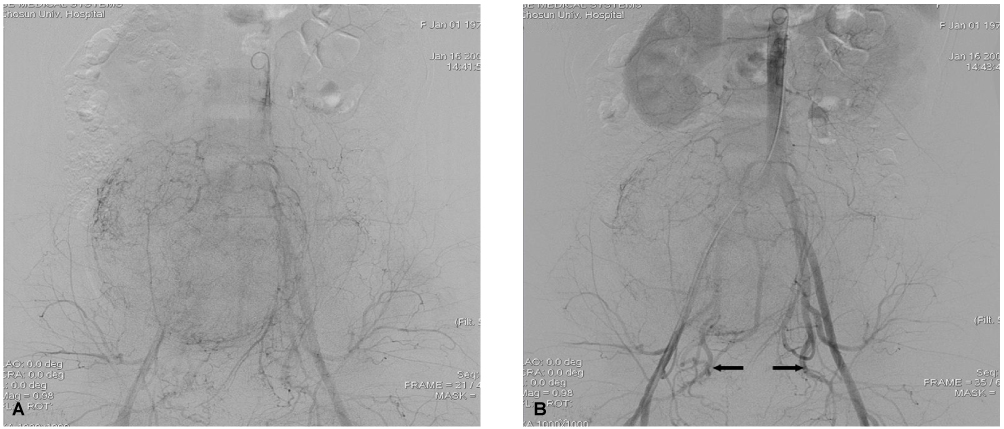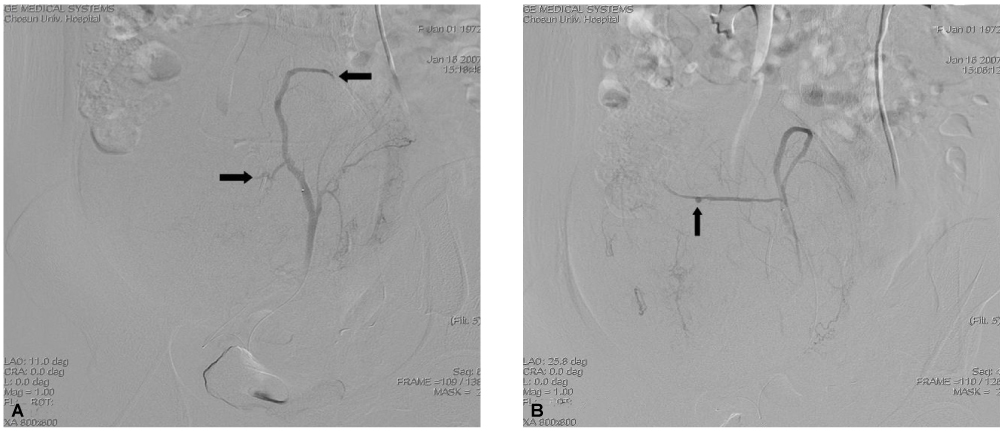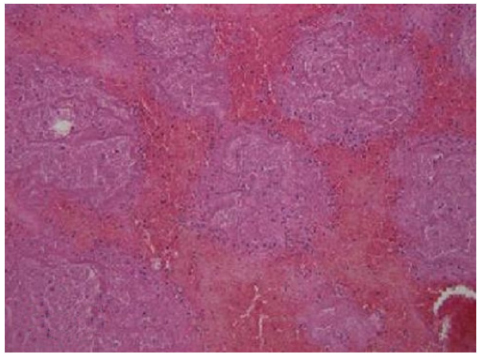Korean J Obstet Gynecol.
2011 Jan;54(1):62-65. 10.5468/KJOG.2011.54.1.62.
Fatal pulmonary thromboembolism after uterine artery embolization for uterine myoma: A case report
- Affiliations
-
- 1Department of Obstetrics and Gynecology, Chosun University School of Medicine, Gwangju, Korea. bimilo@hanmail.net
- KMID: 2274025
- DOI: http://doi.org/10.5468/KJOG.2011.54.1.62
Abstract
- A 34-year-old woman with 10x8 cm sized myoma who was unmarried state willing to be pregnant received uterine artery embolization to treat myoma. There was no problem in pre-operative, per-operative and post-operative laboratory or physical exam but patient had sudden death that later confirmed to be pulmonary thromboembolism in the autopsy. Uterine artery embolization is a minimally invasive method to treat uterine myoma. Although there can be some complications, thromboembolic complications after uterine artery embolization are very infrequent. We present a case of death occurred from a pulmonary embolism after uterine artery embolization to treat uterine myoma.
Keyword
MeSH Terms
Figure
Reference
-
1. Ravina JH, Herbreteau D, Ciraru-Vigneron N, Bouret JM, Houdart E, Aymard A, et al. Arterial embolisation to treat uterine myomata. Lancet. 1995. 346:671–672.2. Bradley EA, Reidy JF, Forman RG, Jarosz J, Braude PR. Transcatheter uterine artery embolisation to treat large uterine fibroids. Br J Obstet Gynaecol. 1998. 105:235–240.3. Goodwin SC, Walker WJ. Uterine artery embolization for the treatment of uterine fibroids. Curr Opin Obstet Gynecol. 1998. 10:315–320.4. Hong JH, Song SH, Lee JK, Oh MJ, Saw HS, Park YK, et al. Uterine artery embolization for leiomyoma. Korean J Obstet Gynecol. 2004. 47:481–486.5. Radeleff B, Rimbach S, Kauffmann GW, Richter GM. Risk and complication rate of uterine fibroid embolization (UFE). Radiologe. 2003. 43:641–650.6. de Blok S, de Vries C, Prinssen HM, Blaauwgeers HL, Jorna-Meijer LB. Fatal sepsis after uterine artery embolization with microspheres. J Vasc Interv Radiol. 2003. 14:779–783.7. Pelage JP, Jacob D, Le Dref O, Lacombe P, Laurent A. Re: fatal sepsis after uterine artery embolization with microspheres. J Vasc Interv Radiol. 2004. 15:405–406.8. Vashisht A, Studd J, Carey A, Burn P. Fatal septicaemia after fibroid embolisation. Lancet. 1999. 354:307–308.9. Spies JB, Spector A, Roth AR, Baker CM, Mauro L, Murphy-Skrynarz K. Complications after uterine artery embolization for leiomyomas. Obstet Gynecol. 2002. 100:873–880.10. Czeyda-Pommersheim F, Magee ST, Cooper C, Hahn WY, Spies JB. Venous thromboembolism after uterine fibroid embolization. Cardiovasc Intervent Radiol. 2006. 29:1136–1140.11. Nikolic B, Kessler CM, Jacobs HM, Abbara S, Ammann AM, Neeman Z, et al. Changes in blood coagulation markers associated with uterine artery embolization for leiomyomata. J Vasc Interv Radiol. 2003. 14:1147–1153.
- Full Text Links
- Actions
-
Cited
- CITED
-
- Close
- Share
- Similar articles
-
- Spontaneous Uterine Rupture after Uterine Artery Embolization for the Treatment of Uterine Myomas
- A Case of Bilateral Uterine Arterial Embolization to Treat Uterine Myoma
- A case of uterine artery embolization for treatment of huge uterine myoma
- A Case of Vaginal Expulsion of Submucosal Fibroid after Uterine Artery Embolization
- Transcervical expulsion of a submucosal myoma as a result of uterine artery embolization




